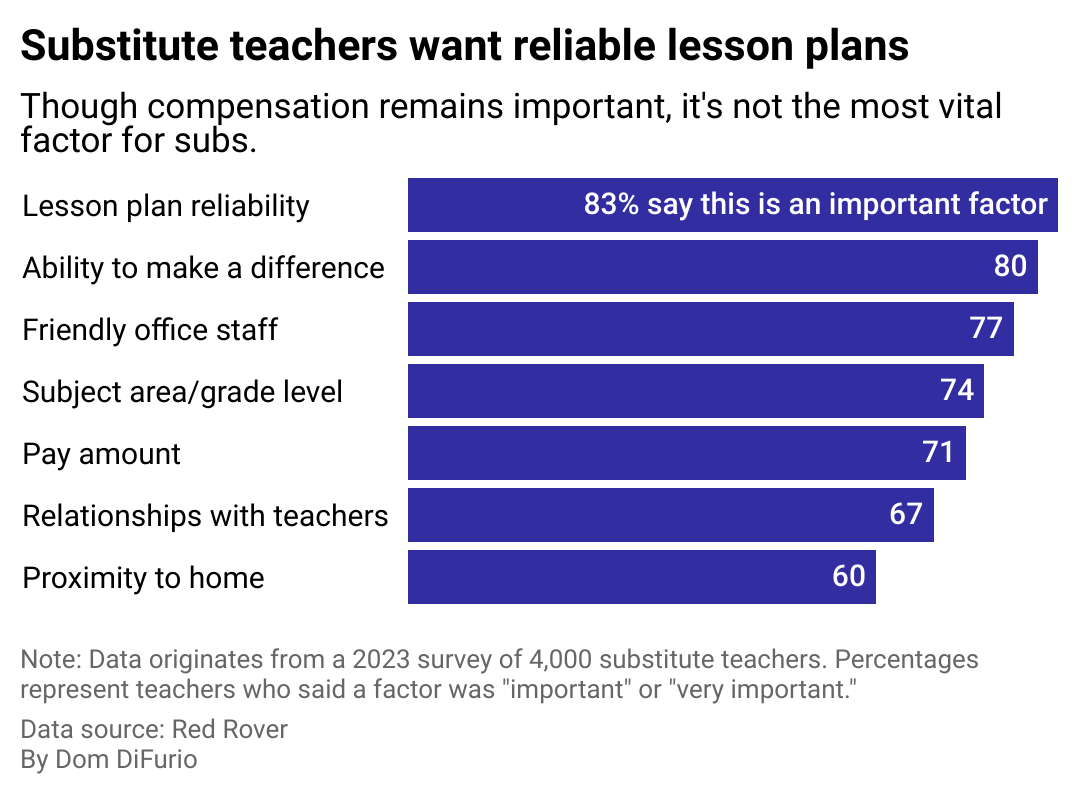Substitute teachers keep schools running. Here are the best ways schools can attract more amid the shortage.

Monkey Business Images // Shutterstock
Substitute teachers keep schools running. Here are the best ways schools can attract more amid the shortage.
A teacher working with young students at a table in a classroom.
Who teaches the kids when their teacher needs time off? Or when they leave their position mid-semester? Increasingly, it’s the principal or other administrators. While substitute teachers provide a turnkey solution when already-thin ranks of educators need time away from work, they’re harder than ever for school districts to come by.
In the 2023-24 school year, 35% of public schools reported having difficulty finding substitutes, according to NCES data. It’s a trend that’s accelerated in the aftermath of the pandemic, along with teacher absenteeism and turnover, placing additional pressure on administrators to find qualified substitute teachers.
HeyTutor analyzed survey data from education HR management provider Red Rover to break down the factors substitute teachers prioritize when deciding whether or not to take an assignment at a school. The data is from a 2023 survey of 4,000 substitutes.
In around 70% of public schools, administrators fill in for teachers when substitutes aren’t available—a short-term solution to a problem that existed well before the pandemic.
The coronavirus pandemic exacerbated the shortage of public school teachers, with fewer Americans entering the education field and an increasing number of existing teachers retiring or leaving their positions. This combo of factors strained the already slim number of substitute teachers, a portion of whom now tend to be parents of children in the school system.
The teacher shortage is especially acute in the South, where there were 16 missing teachers for every 10,000 students in 2022, well above the national average of 11 vacant teaching positions per 10,000 students, according to Department of Education data.
Research suggests that teachers at schools where large portions of the student body live in low-income areas have had even more difficulty finding substitutes to cover their classes than at other, more privileged schools. And it’s Black and Hispanic students that most often go without any teacher at all when substitutes are needed.
![]()

HeyTutor
Substitutes care more about work culture and reliable lesson plans than pay
A stacked bar chart showing the percentage of substitutes that rated elements of substitute teaching as very important or important for them when choosing an assignment. 84% rate lesson plans as very important or important, followed by knowing they can make a difference, friendly office staff, the subject or grade level, the pay amount, relationships with teachers, and proximity to home.
Substitute teachers have plenty of good things to say about the job. Benefits include flexible schedules and the chance to impact young people’s lives. However, even though substitute teachers tend to be quick thinkers accustomed to dealing with the unexpected, they prefer not to walk into a classroom unprepared.
Getting solid lesson plans from absent teachers ranks highest for substitute teachers considering taking a job. They also say that friendly office staff and knowing they can make a difference for kids are critical factors in deciding whether to take an assignment. Brown Center on Education Policy researchers found that substitutes develop favorite schools and tend to form those opinions based most often on their perceptions of student behavior.
Education professionals are working to remedy classroom absences on two fronts: attracting and retaining more teachers, and finding new ways to incentivize substitutes.
In the Seattle area, schools have hired full-time “floating teachers” in recent years to cover for absent teachers in weekly increments rather than days. The Columbus, Ohio, school district has tried keeping a permanent substitute teacher on staff to serve each school. In Chicago, administrators found some success in offering 50% more pay for substitute roles in hard-to-staff schools.
Posting about teacher absences as soon as possible and giving substitute teachers more lead time for jobs also increases the success rate, according to an analysis from the Brookings Institute, a nonpartisan think tank.
Finding adequate subs isn’t easy, but schools can assess factors like compensation and lesson plan preparation to increase their chances of filling absent positions. It’s worth the effort—Brookings authors say the quality of substitute teachers can impact student learning outcomes.
Story editing by Alizah Salario. Copy editing by Kristen Wegrzyn.
This story originally appeared on HeyTutor and was produced and
distributed in partnership with Stacker Studio.





